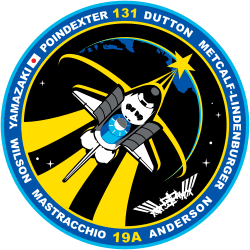Alan Goodwin Poindexter
| Alan Poindexter | |
|---|---|
 | |
| Land | USA |
| Organisation | NASA |
| ausgewählt | 4. Juni 1998 (17. NASA-Gruppe) |
| Einsätze | 2 Raumflüge |
| Start des ersten Raumflugs | 7. Februar 2008 |
| Landung des letzten Raumflugs | 20. April 2010 |
| Zeit im Weltraum | 27d 21h 09min |
| ausgeschieden | 10. Dezember 2010 |
| Raumflüge | |
Alan Goodwin Poindexter (* 5. November 1961 in Pasadena, Kalifornien; † 1. Juli 2012 in Pensacola, Florida[1]) war ein US-amerikanischer Astronaut.
Leben
Ausbildung
Poindexter erwarb 1986 einen Bachelor in Luft- und Raumfahrttechnik vom Georgia Institute of Technology und 1995 einen Master als Luftfahrttechniker von der Naval Postgraduate School in Kalifornien.
Nachdem er sein Bachelor-Diplom erhalten hatte, trat Poindexter in die US Navy ein und wurde in Florida zum Piloten ausgebildet. Es folgte eine Weiterbildung auf Kampfjets des Typs F-14 Tomcat. Mit dem Fighter Squadron 211 wurde er zweimal in den Persischen Golf entsandt und flog Einsätze während des Zweiten Golfkriegs. Anschließend wurde er zum Testpiloten geschult und arbeitete auf dem Stützpunkt Patuxent River in Maryland an einem digitalen Kontrollsystem für die F-14.
Astronautentätigkeit
Im Juni 1998 wurde Poindexter von der NASA als Astronautenanwärter ausgewählt. Nach der zweijährigen Grundausbildung war er Leiter der Astronautenunterstützungsmannschaften am Kennedy Space Center.
STS-122
Ab Sommer 2006 trainierte Poindexter für seinen ersten Raumflug als Pilot der Shuttle-Mission STS-122, die im Februar 2008 durchgeführt wurde. Hauptnutzlast war das europäische Raumlabor Columbus, das an die Internationale Raumstation angedockt wurde.
STS-131
Am 5. Dezember 2008 wurde Poindexter als Kommandant für die Mission STS-131 benannt.[2] Der Start erfolgte am 5. April 2010, die Landung am 20. April 2010.[3]
Abschluss der Astronautenlaufbahn
Am 10. Dezember 2010 verließ Poindexter das NASA-Astronauten-Korps, um an seiner früheren Schule, der Naval Postgraduate School in Monterey, Kalifornien, als Ausbilder tätig zu sein.[4]
Privates
Poindexter, der verheiratet war und zwei Kinder hatte, war einer von fünf Söhnen des ehemaligen Sicherheitsberaters von US-Präsident Ronald Reagan, USN-Admiral John Poindexter. Alan Poindexter starb am 1. Juli 2012 infolge eines Jet-Ski-Unfalls in Pensacola.
Auszeichnungen
Auswahl der Dekorationen, sortiert in Anlehnung der Order of Precedence of Military Awards:
- Legion of Merit
 Distinguished Flying Cross
Distinguished Flying Cross- Defense Meritorious Service Medal
 Navy & Marine Corps Commendation Medal
Navy & Marine Corps Commendation Medal- Navy & Marine Corps Achievement Medal
 National Defense Service Medal
National Defense Service Medal- Southwest Asia Service Medal
Siehe auch
Weblinks
- Kurzbiografie von Alan Goodwin Poindexter bei spacefacts.de
- Biografie von Alan Goodwin Poindexter in der Encyclopedia Astronautica (englisch)
- NASA-Biografie von Alan Goodwin Poindexter (englisch; PDF)
Einzelnachweise
- ↑ Retired Astronaut Dies In Pensacola Beach Jet Ski Accident
- ↑ NASA Assigns Astronaut Crews for Future Space Shuttle Missions. NASA, 5. Dezember 2008, abgerufen am 7. Dezember 2008 (englisch).
- ↑ STS-131 Mission Information. NASA, 20. April 2010, abgerufen am 2. April 2010 (englisch).
- ↑ Astronaut Alan Poindexter Leaves NASA. NASA, 13. Dezember 2010, abgerufen am 13. Dezember 2010 (englisch).
| Personendaten | |
|---|---|
| NAME | Poindexter, Alan Goodwin |
| KURZBESCHREIBUNG | US-amerikanischer Astronaut |
| GEBURTSDATUM | 5. November 1961 |
| GEBURTSORT | Pasadena, Kalifornien |
| STERBEDATUM | 1. Juli 2012 |
| STERBEORT | Pensacola, Florida |
Auf dieser Seite verwendete Medien
Legion of Merit Legionnare ribbon
Ribbon from the Defense Meritorious Service Medal awarded by the United States Department of Defense.
The original version of the Southwest Asia Service Medal ribbon used from 1991 to 2016. It was redesigned in April 2016.
Emblem of Nasa's STS-122 mission.
- The STS-122 patch depicts the continuation of the voyages of the early explorers to today's frontier, space. The ship denotes the travels of the early expeditions from the east to the west. The space shuttle shows the continuation of that journey along the orbital path from west to east. A little more than 500 years after Columbus sailed to the new world, the STS-122 crew will bring the European laboratory module "Columbus" to the International Space Station to usher in a new era of scientific discovery.
The STS-131/19A crew patch highlights the Space Shuttle in the Rendezvous Pitch Maneuver (RPM). This maneuver is heavily photographed by the International Space Station (ISS) astronauts, and the photos are analyzed back on earth to clear the Space Shuttle's thermal protection system for re-entry. The RPM illustrates the teamwork and safety process behind each Space Shuttle launch. In the Space Shuttle's cargo bay is the Multi-Purpose Logistics Module (MPLM), Leonardo, which is carrying several science racks, the last of the four crew quarters, and supplies for the ISS. Out of view and directly behind the MPLM, is the Ammonia Tank Assembly (ATA) that will be used to replace the current ATA. This will take place during three Extra Vehicular Activities (EVAs). The 51.6° Space Shuttle orbit is illustrated by the three gold bars of the astronaut symbol, and its elliptical wreath contains the orbit of the ISS. The star atop the astronaut symbol is the dawning sun, which is spreading its early light across the Earth. The background star field contains seven stars, one for each crewmember; they are proud to represent the United States and Japan during this mission.
Ribbon from the Distinguished Flying Cross (United States) awarded by the United States Department of Defense.
Ribbon for the Achievement Medal awarded by the United States Department of the Navy.
Ribbon for the Navy and Marine Corps Commendation Medal awarded by the United States Department of the Navy.
Ribbon from the National Defense Service Medal awarded by the United States Department of Defense.









